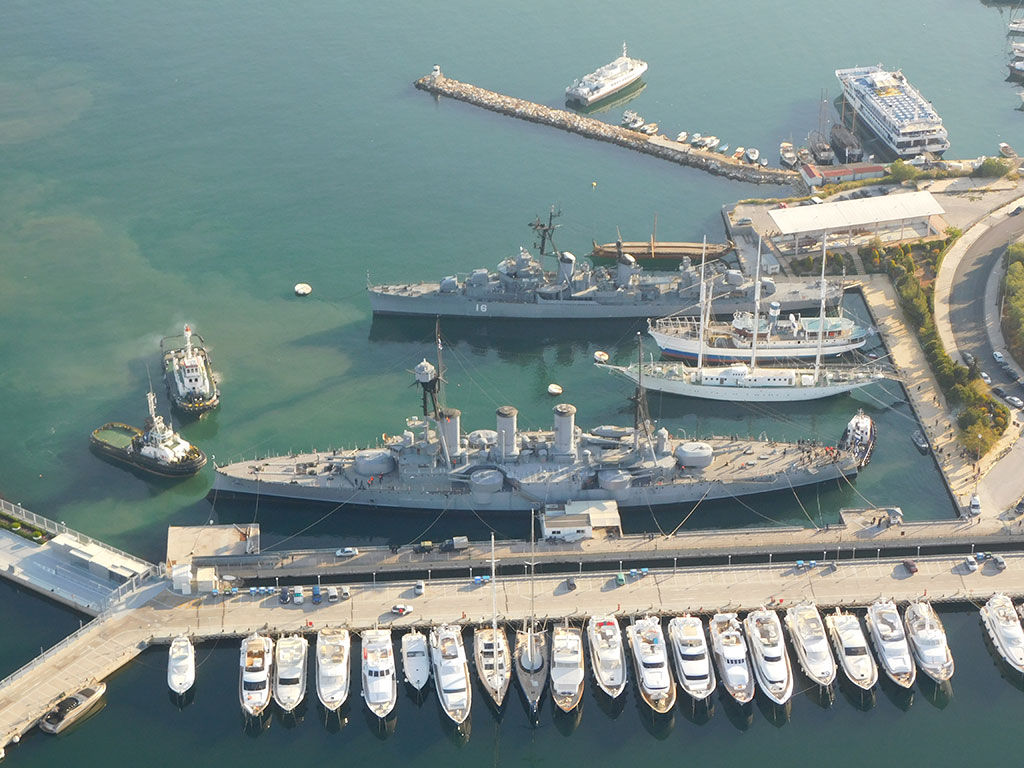“Eugenios Eygenidis”
The historic “Eugenios Eygenidis” sailboat was built for Walter Runciman. It was a constructive masterpiece, a result of the collaboration of the shipyards William & Denny Bros. in Dumbarton, Scotland, by designer G. L. Watson and sail makers Ratrsey & Lapthorn. It was settled in 1929 and until 1939 was used mainly as the personal home of the Runciman family. During the World War II it was used as a special mission ship by the Allies on the Helford River in Cornwall.
In 1945 the ship falls into Swedish hands, first to the “Abraham Rydberg Foundation of Stockholm” and then to “Einar Hansen’s Clipper Line of Malmo”, where it is renamed “SUNBEAM” and “FLYING CLIPPER” respectively. In 1965 it changed it’s sailing, with the addition of three sails, and used it as an educational sailing boat for the crews of its owners.
Starring in the film “FLYING CLIPPER”, she participates in the film “Lord Jim”, and is distinguished in the first two high sailboat races (1956 -1958), which also includes Stavros Niarchos’ personal crew, “CREOLE”.
In 1965 it was purchased by the Ministry of Merchant Shipping and renamed “Eugenios Eugenidis”, in honour of the benefactor Eugenios Eugenides, whose legacy derives 1/3 of the money for the purchase of the boat. “Eugenios Eugenidis” continues to play the role of an educational sailboat, this time for the Merchants of the Merchant Navy, until 1990. After his decommissioning, “Eugenios Eugenidis” is transferred to the Ministry of Culture, which grants its use to the Maritime Museum of Greece.
Since 2004, the Greek Navy has started the ship’s maintenance in order to make it public.
Destroyer “Velos”
The destroyer “Velos” , Museum of Anti-dictatorial Combat is one of the 25 ships of the Greek Fleet whose Commanders and Officers had decided to react vigorously to overthrow the military junta regime imposed in 1967. They organized an anti-dictatorial movement that had been in various forms and fluctuations since 1968, culminating in May 1973 involving almost the entire Fleet. Over 150 Initiated Officers who held important positions in the fleet came up with the action plan. The plan was to be implemented on the night of May 22 to May 23, 1973 and provided for various actions, such as sending a telegraph with a modern demonstration of Fleet strength, to force dictators to relinquish power. The peculiarity of the Navy’s movement was that the Navy Officers did not intend to seize power themselves but their sole purpose was to return to parliamentary democracy. Despite careful and lengthy preparation, the movement was betrayed in the last 24 hours. 60 Officers of the Navy, 4 of the Army and 4 of the Air Force were arrested and imprisoned, detained, tortured under the miserable conditions and barbaric of the junta, without denying their participation.
While these took part in Athens, the initiated commander of the destroyer “Velos”, one of the leaders in the NATO exercise, was informed of the arrests of his colleagues on the afternoon of May 25. His reaction is immediate. It decides to withdraw from the exercise and transmits a signal to all NATO authorities, denouncing the free regime of Athens and the arrests of the Officers, and at the same time informs the international news agencies. His rebellion was intended to bring to the public’s attention the extent and seriousness of the Movement. He informed the crew that he would sail to Fiumicino, Italy, and his decision was universally accepted with excitement. Finally, the Governor agreed to be followed by 6 officers and 25 petty officers. The Commander and crew were constantly informed by international public opinion, governments, NATO authorities and organizations about the situation in Greece and carried out anti-dictatorial actions to bring every possible blow to the regime.
After the post-war (24/7/1974), by special decree, all the enlisted Officers and Officers of the Movement are recalled to active service and reintroduced to neuralgic positions in the Fleet and Staffs. The state honoured them with a special medal for their anti-dictatorial action. It designates “Velos” as the Museum of the Anti-dictatorship of the Armed Forces and establishes May 23 as the anniversary and commemoration day of the Movement on the Ship. The Ship now hosts archive material, press, photographs etc. related to the Movement, in order to preserve the historical memory of the Navy’s contribution to the restoration of Democracy.
Ancient Athenian Trireme “Olympias”
For centuries the controversy over how the Trireme was made and manned continued. These questions were answered definitively in the summer of 1987. Then the copy of the Athenian Trireme, “Olympias” fitted with paddles of the same length, constructed in accordance with the archaeological data and the laws of Physics, material strength, etc., was answered and tested.
The performance of Trireme “Olympias” was amazing. It could reach speeds of over 9 knots, sail for 4 knots at half speed rowers, rotate 180 degrees in one minute with a bow of less than 2.5 boat lengths. In addition, the crew did not need long training. The paddlers were synchronized to the paddles in a few weeks.
Trireme “Olympias” specifications
Date of receipt: August 26, 1987
Construction Material: Housing – Oregon Pine, County – Oak Virginia, Iroquois Karen, 20,000 wooden wedges, 17,000 handmade brass nails, 200kg Piston Brass Hood.
Shipbuilding Details: Length 36.90 m. Width 5.50 m. Depth 1.25 m. Displacement 70 tonnes.



